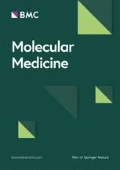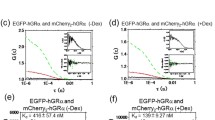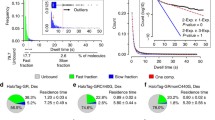Abstract
Natural mutations of the human glucocorticoid receptor (GR) isoform α cause the glucocorticoid resistance syndrome. Mutant receptors may have abnormal interactions with the ligand, target DNA sequences, and/or multiple intracellular proteins, as well as aberrant nucleocytoplasmic trafficking. Using fluorescence recovery after photobleaching (FRAP) analysis, all GR pathologic mutant receptors examined, as well as 2 synthetic GR mutants lacking the activation function (AF)-1 or the ligand-binding domain (and hence the AF-2), had defective transcriptional activity and dynamic motility defects inside the nucleus of living cells. In the presence of dexamethasone, these mutants displayed a curtailed 50% recovery time (t1/2) after photobleaching and, hence, significantly increased intranuclear motility and decreased “chromatin retention.” The t1/2 values of the mutants correlated positively with their transcriptional activities and depended on the GR domain affected. GRβ, a natural splice variant of the GR gene, also demonstrated a shorter t1/2 than GRa. The motility responsiveness of the natural and artificial mutant receptors examined, and of GRβ, to the proteasomal inhibitor MG-132 also depended on the mutant domain. Thus, mutant glucocorticoid receptors possess dynamic motility defects in the nucleus, possibly caused by their inability to properly interact with all key partner nuclear molecules necessary for full activation of glucocorticoid-responsive genes.






Similar content being viewed by others
References
Kino T, De Martino MU, Charmandari E, Mirani M, Chrousos GP. (2003) Tissue glucocorticoid resistance/hypersensitivity syndromes. J. Steroid Biochem. Mol. Biol. 85: 457–467.
Kino T, Chrousos GP. (2004) Glucocorticoid and mineralocorticoid receptors and associated diseases. Essays Biochem. 40: 137–155.
Charmandari E, Kino T, Chrousos GP. (2004) Familial/sporadic glucocorticoid resistance: clinical phenotype and molecular mechanisms. Ann. N. Y. Acad. Sci. 1024: 168–181.
Karl M et al. (1993) Familial glucocorticoid resistance caused by a splice site deletion in the human glucocorticoid receptor gene. J. Clin. Endocrinol. Metab. 76: 683–689.
Karl M et al. (1996) Cushing’s disease preceded by generalized glucocorticoid resistance: clinical consequences of a novel, dominant-negative glucocorticoid receptor mutation. Proc. Assoc. Am. Physicians 108: 296–307.
Kino T, Stauber RH, Resau JH, Pavlakis GN, Chrousos GP. (2001) Pathologic human GR mutant has a transdominant negative effect on the wild-type GR by inhibiting its translocation into the nucleus: importance of the ligand-binding domain for intracellular GR trafficking. J. Clin. Endocrinol. Metab. 86: 5600–5608.
Malchoff DM et al. (1993) A mutation of the glucocorticoid receptor in primary cortisol resistance. J. Clin. Invest. 91: 1918–1925.
Vottero A, Kino T, Combe H, Lecomte P, Chrousos GP. (2002) A novel, C-terminal dominant negative mutation of the GR causes familial glucocorticoid resistance through abnormal interactions with p160 steroid receptor coactivators. J. Clin. Endocrinol. Metab. 87: 2658–2667.
Hurley DM et al. (1991) Point mutation causing a single amino acid substitution in the hormone binding domain of the glucocorticoid receptor in familial glucocorticoid resistance. J. Clin. Invest. 87: 680–686.
Mendonca BB et al. (2002) Female pseudohermaphroditism caused by a novel homozygous missense mutation of the GR gene. J. Clin. Endocrinol. Metab. 87: 1805–1809.
Ruiz M et al. (2001) Characterization of two novel mutations in the glucocorticoid receptor gene in patients with primary cortisol resistance. Clin. Endocrinol. (Oxf) 55: 363–371.
Charmandari E et al. (2005) A novel point mutation in the ligand-binding domain (LBD) of the human glucocorticoid receptor (hGR) causing generalized glucocorticoid resistance: the importance of the C terminus of hGR LBD in conferring transactivational activity. J. Clin. Endocrinol. Metab. 90: 3696–3705.
Charmandari E, Kino T, Souvatzoglou E, Vottero A, Bhattacharyya N, Chrousos GP. (2004) Natural glucocorticoid receptor mutants causing generalized glucocorticoid resistance: molecular genotype, genetic transmission, and clinical phenotype. J. Clin. Endocrinol. Metab. 89: 1939–1949.
Kino T, Chrousos GP. (2004) Glucocorticoid Effect on Gene Expression. In: Handbook on Stress and the Brain Part 1. Steckler T, Kalin NH, Reul JMHM (eds.) Elsevier BV, Amsterdam, pp. 295–312.
Lu NZ, Cidlowski JA. (2005) Translational regulatory mechanisms generate N-terminal glucocorticoid receptor isoforms with unique transcriptional target genes. Mol. Cell 18: 331–342.
de Castro M et al. (1996) The non-ligand binding β-isoform of the human glucocorticoid receptor (hGRβ): tissue levels, mechanism of action, and potential physiologic role. Mol. Med. 2: 597–607.
Wallace AD, Cidlowski JA. (2001) Proteasome-mediated glucocorticoid receptor degradation restricts transcriptional signaling by glucocorticoids. J. Biol. Chem. 276: 42714–42721.
Stavreva DA, Muller WG, Hager GL, Smith CL, McNally JG. (2004) Rapid glucocorticoid receptor exchange at a promoter is coupled to transcription and regulated by chaperones and proteasomes. Mol. Cell. Biol. 24: 2682–2697.
Becker M et al. (2002) Dynamic behavior of transcription factors on a natural promoter in living cells. EMBO Rep. 3: 1188–1194.
McNally JG, Muller WG, Walker D, Wolford R, Hager GL. (2000) The glucocorticoid receptor: rapid exchange with regulatory sites in living cells. Science 287: 1262–1265.
Nagaich AK et al. (2004) Subnuclear trafficking and gene targeting by steroid receptors. Ann. N. Y. Acad. Sci. 1024: 213–220.
Deroo BJ, Rentsch C, Sampath S, Young J, DeFranco DB, Archer TK. (2002) Proteasomal inhibition enhances glucocorticoid receptor transactivation and alters its subnuclear trafficking. Mol. Cell. Biol. 22: 4113–4123.
Charmandari E, Kino T, Ichijo T, Zachman K, Chrousos GP. (2005) Molecular characterization of the human glucocorticoid receptor (hGR) gene mutations hGRαR477H and hGRαG679S causing generalized glucocorticoid resistance: absence of dominant negative activity despite asymmetric binding to p160 coactivators. The Endocrine Society’s 87th Annual Meeting, San Diego, The Endocrine Society Press, Chevy Chase, MD, p647.
Kino T, Tiulpakov A, Ichijo T, Chheng L, Kozasa T, Chrousos GP. (2005) G protein β interacts with the glucocorticoid receptor and suppresses its transcriptional activity in the nucleus. J. Cell Biol. 169: 885–896.
Kino T, Nordeen SK, Chrousos GP. (1999) Conditional modulation of glucocorticoid receptor activities by CREB-binding protein (CBP) and p300. J. Steroid Biochem. Mol. Biol. 70: 15–25.
Schaaf MJ, Cidlowski JA. (2003) Molecular determinants of glucocorticoid receptor mobility in living cells: the importance of ligand affinity. Mol. Cell. Biol. 23: 1922–1934.
Wang X, DeFranco DB. (2005) Alternative effects of the ubiquitin-proteasome pathway on glucocorticoid receptor down-regulation and transactivation are mediated by CHIP, an E3 ligase. Mol. Endocrinol. 19: 1474–1482.
Fletcher TM et al. (2002) ATP-dependent mobilization of the glucocorticoid receptor during chromatin remodeling. Mol. Cell. Biol. 22: 3255–3263.
Stenoien DL et al. (2001) FRAP reveals that mobility of oestrogen receptor-α is ligand- and proteasome-dependent. Nat. Cell Biol. 3: 15–23.
Wallberg AE, Flinn EM, Gustafsson JA, Wright AP. (2000) Recruitment of chromatin remodelling factors during gene activation via the glucocorticoid receptor N-terminal domain. Biochem. Soc. Trans. 28: 410–414.
Hittelman AB, Burakov D, Iniguez-Lluhi JA, Freedman LP, Garabedian MJ. (1999) Differential regulation of glucocorticoid receptor transcriptional activation via AF-1-associated proteins. EMBO J. 18: 5380–5388.
Webb P et al. (1998) Estrogen receptor activation function 1 works by binding p160 coactivator proteins. Mol. Endocrinol. 12: 1605–1618.
Kinyamu HK, Chen J, Archer TK. (2005) Linking the ubiquitin-proteasome pathway to chromatin remodeling/modification by nuclear receptors. J. Mol. Endocrinol. 34: 281–297.
Dennis AP, O’Malley BW. (2005) Rush hour at the promoter: how the ubiquitinproteasome pathway polices the traffic flow of nuclear receptor-dependent transcription. J. Steroid Biochem. Mol. Biol. 93: 139–151.
Jason LJ, Moore SC, Lewis JD, Lindsey G, Ausio J. (2002) Histone ubiquitination: a tagging tail unfolds? Bioessays 24: 166–174.
Gillette TG, Gonzalez F, Delahodde A, Johnston SA, Kodadek T. (2004) Physical and functional association of RNA polymerase II and the proteasome. Proc. Natl. Acad. Sci. U. S. A. 101: 5904–5909.
LaMorte VJ, Dyck JA, Ochs RL, Evans RM. (1998) Localization of nascent RNA and CREB binding protein with the PML-containing nuclear body. Proc. Natl. Acad. Sci. U. S. A. 95: 4991–4996.
Baumann CT et al. (2001) The glucocorticoid receptor interacting protein 1 (GRIP1) localizes in discrete nuclear foci that associate with ND10 bodies and are enriched in components of the 26S proteasome. Mol. Endocrinol. 15: 485–500.
Oakley RH, Sar M, Cidlowski JA. (1996) The human glucocorticoid receptor β isoform. Expression, biochemical properties, and putative function. J. Biol. Chem. 271: 9550–9559.
Vottero A, Chrousos GP. (1999) Glucocorticoid receptor β: view I. Trends Endocrinol. Metab. 10: 333–338.
Charmandari E et al. (2005) The human glucocorticoid receptor (hGR) β isoform suppresses the transcriptional activity of hGRα by interfering with formation of active coactivator complexes. Mol. Endocrinol. 19: 52–64.
Kino T, Manoli-Oreopoulos I, Kelkar S, Su AY, Blackman MR, Chrousos GP. (2005) The human glucocorticoid receptor (GR) β isoform, a splicing variant of the classic receptor GRα, exerts intrinsic transcriptional effects in HeLa cells. The Endocrine Society’s 87th Annual Meeting, San Diego, The Endocrine Society Press, Chevy Chase, MD, p.422.
Acknowledgments
This study was funded in part by the National Institute of Child Health and Human Development, National Institutes of Health, Bethesda, MD, USA. We thank Drs. R.M. Evans and G.L. Hager for providing their plasmids, and Dr. T. Ichijo, S.S. Rao, and K. Zachman for superb technical assistance.
Author information
Authors and Affiliations
Corresponding author
Rights and permissions
About this article
Cite this article
Kino, T., Liou, SH., Charmandari, E. et al. Glucocorticoid Receptor Mutants Demonstrate Increased Motility Inside the Nucleus of Living Cells: Time of Fluorescence Recovery After Photobleaching (FRAP) Is an Integrated Measure of Receptor Function. Mol Med 10, 80–88 (2004). https://doi.org/10.2119/2005-00026.Kino
Received:
Accepted:
Published:
Issue Date:
DOI: https://doi.org/10.2119/2005-00026.Kino




